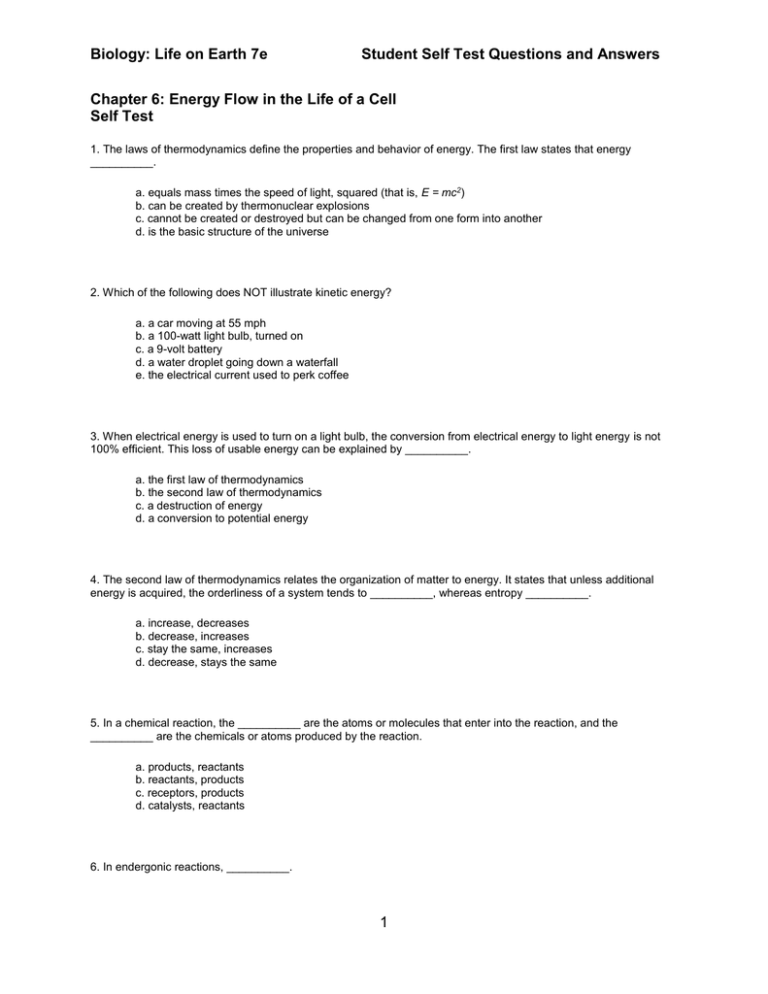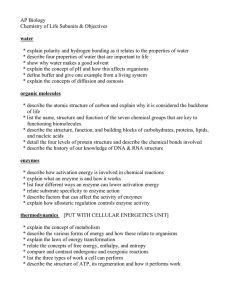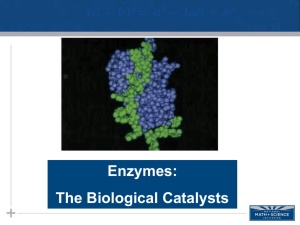Biology: Life on Earth 7e Student Self Test Questions and Answers
advertisement

Biology: Life on Earth 7e Student Self Test Questions and Answers Chapter 6: Energy Flow in the Life of a Cell Self Test 1. The laws of thermodynamics define the properties and behavior of energy. The first law states that energy __________. a. equals mass times the speed of light, squared (that is, E = mc2) b. can be created by thermonuclear explosions c. cannot be created or destroyed but can be changed from one form into another d. is the basic structure of the universe 2. Which of the following does NOT illustrate kinetic energy? a. a car moving at 55 mph b. a 100-watt light bulb, turned on c. a 9-volt battery d. a water droplet going down a waterfall e. the electrical current used to perk coffee 3. When electrical energy is used to turn on a light bulb, the conversion from electrical energy to light energy is not 100% efficient. This loss of usable energy can be explained by __________. a. the first law of thermodynamics b. the second law of thermodynamics c. a destruction of energy d. a conversion to potential energy 4. The second law of thermodynamics relates the organization of matter to energy. It states that unless additional energy is acquired, the orderliness of a system tends to __________, whereas entropy __________. a. increase, decreases b. decrease, increases c. stay the same, increases d. decrease, stays the same 5. In a chemical reaction, the __________ are the atoms or molecules that enter into the reaction, and the __________ are the chemicals or atoms produced by the reaction. a. products, reactants b. reactants, products c. receptors, products d. catalysts, reactants 6. In endergonic reactions, __________. 1 Biology: Life on Earth 7e Student Self Test Questions and Answers a. the reactants have more potential energy than the products b. energy is released c. a net input of energy is not required d. all of the above e. none of the above 7. Activation energy __________. a. is required for endergonic reactions b. is produced by exergonic reactions c. is required for all chemical reactions d. is produced by chemical reactions 8. Energy from exergonic reactions is transferred from place to place in cells via __________. a. microscopic channels b. energy-carrier molecules such as ATP c. glucose d. mitochondria 9. The speed of a reaction is determined by its __________. a. reactants b. products c. activation energy d. potential energy . 10. Enzymes are a class of proteins that catalyze chemical reactions in cells. Like all other catalysts, they speed up chemical reactions by __________. a. making the reaction endergonic b. releasing energy for the reaction c. lowering the activation energy of the reaction d. elevating the activation energy of the reaction 11. Which of the following are correct statements about how enzymes work? a. Enzymes catalyze specific chemical reactions because the shape of their active site allows only certain substrate molecules to enter. b. The substrate(s) enter the enzyme active site in specific orientations. c. The enzyme and the substrate(s) change shape, promoting a specific chemical reaction and then allowing the products to leave. d. The first three answers are all correct. e. Only the first two answers are correct. 2 Biology: Life on Earth 7e Student Self Test Questions and Answers 12. The most important reason a particular enzyme can function only within certain limits of temperature, salt conditions, and pH is that __________. a. changes in temperature, salt, and pH change the shape of an enzyme b. changes in temperature, salt, and pH alter the amount of substrates c. changes in temperature, salt, and pH alter the amount of products d. changes in temperature, salt, and pH lower the activation energy of a reaction 13. ATP is well suited to its role as an energy-carrier molecule in cells because __________. a. the covalent bond between the last two phosphates can be broken to release substantial amounts of energy b. it contains covalent bonds c. it is small and can fit into a lot of places in the cell d. the covalent bonds between the last two phosphates are high-energy bonds that can absorb a substantial amount of energy when the bonds are broken 14. A substance that is acted upon by an enzyme to produce a product is called a(n) __________. a. allosteric inhibitor b. coenzyme c. substrate d. electron carrier . 15. Which of the following situations illustrates the coupling of exergonic to endergonic reactions in cells? a. the production of ATP by breakdown of glucose b. the active transport of sodium into the cell c. the movement of a muscle powered by the hydrolysis of ATP d. All of the above are correct. 16. If all matter tends toward increasing randomness and disorder, how can life exist? a. Living things do not obey the second law of thermodynamics. b. There is a constant input of energy from the sun. c. Living things do not require energy. d. All of the above are true. 17. The amino acid threonine is converted to isoleucine by a sequence of five enzymatic reactions. When isoleucine levels are high, the first reaction in this sequence is “turned off.” This is an example of __________. a. substrate activation b. feedback inhibition c. competitive inhibition d. coenzyme activation 3 Biology: Life on Earth 7e Student Self Test Questions and Answers 18. The laws of thermodynamics __________. a. explain how energy is created and destroyed b. refer to fluctuating temperature changes c. define the basic properties and behavior of energy d. suggest that matter in a disorganized state requires energy to be constantly added to maintain the "disorganization" 19. Why do most reactions occur more rapidly at high temperature? a. Molecules move more rapidly at higher temperatures. b. Collisions between molecules are more frequent. c. Collisions will be hard enough to force electron shells to interact. d. All of the above are correct. 20. Pepsin is an enzyme that breaks down protein but will not act upon starch. This fact is an indication that enzymes are __________. a. catalytic b. hydrolytic c. specific d. temperature sensitive 21. Biological catalysts __________. a. are organic substances that lower the activation energy required to initiate a reaction that would normally take place at a slower rate b. are broken down and destroyed as part of the chemical process they help initiate c. are seldom regulated by the molecules that participate in the catalyzed reactions d. can speed up any reaction, even those that would not occur naturally 22. Which of the following is NOT used by an enzyme to promote a reaction? a. substrate orientation b. temporary chemical bonds c. electrical interactions d. increased kinetic energy of substrate e. bond distortion 23. Enzyme regulation can be precisely controlled through a variety of mechanisms such as __________. a. production of an inactive form of an enzyme that will become activated only when needed b. using a coenzyme that is necessary for function 4 Biology: Life on Earth 7e Student Self Test Questions and Answers c. binding of a competitive inhibitor to the active site d. all of the above 24. Lysosomes have an acidic interior (pH = 5), unlike the rest of the cell (pH = 7). Lysosomal enzymes are most active at __________. a. pH = 4 b. pH = 5 c. pH = 7 d. pH = 9 25. Which of the following is NOT true about enzymes? a. Enzymes are biological catalysts. b. Enzymes are proteins. c. Enzymes, like other reactants, are used up in the reactions that they catalyze. d. Enzymes are very specific for the reactions that they catalyze. 26. The energy of movement is called ____________________. 27. Without energy, processes that proceed spontaneously result in an increase in ____________________. 28. A ____________________ is a process that breaks and forms chemical bonds. 29. ____________________ is the most common energy-carrier molecule in cells. 30. The ____________________ of a cell is the sum of all of its chemical reactions. 31. ____________________ are biological catalysts synthesized by living organisms. 5 Biology: Life on Earth 7e Student Self Test Questions and Answers 32. Identify the compounds in the diagram below indicating the equation for energy storage. 6 Biology: Life on Earth 7e Student Self Test Questions and Answers 33. Identify the activation energy curves on the graph below. 7 Biology: Life on Earth 7e Student Self Test Questions and Answers 34. Label the structures associated with enzyme activity in the figure below. 8 Biology: Life on Earth 7e Student Self Test Questions and Answers 35. Using the same image as in Question 34, place the sequence of enzyme–substrate activity in the proper order. 9




